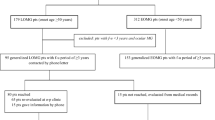Abstract
The objectives of the study are to study the clinical features of myasthenia gravis in southern China. A retrospective study was carried out on all patients who were diagnosed with myasthenia gravis at the First Affiliated Hospital of Sun Yat-sen University during 1987–2009. Of the 2,154 myasthenia gravis patients, the gender ratio (male:female) was 1:1.15. The median age at onset was 18 years. There was a single peak distribution of age at onset, and 44.8 % were children (≤14 years) at first onset. 1,766 patients (82.0 %) only had ocular symptoms at onset. 1,451 patients (67.4 %) were classified as Osserman grade I. 250 unselected patients received anti-acetylcholine receptor antibodies test, in which only 51.2 % were positive. Computed tomography scan/magnetic resonance Imaging of chest were done in 1,354 patients, of which 899 patients (66.4 %) had thymic hyperplasia and 201(14.8 %) had thymoma. There were 150 patients (7.0 %) with myasthenia gravis combined with other autoimmune diseases, in which hyperthyroidism was most common (84 %). 189 (8.8 %) patients experienced 267 episodes of crisis. The rate of family myasthenia gravis was 1.6 % (35/2,154). In conclusion, the clinical features and demography of myasthenia gravis patients in this study are significantly different from prior studies on other regions and ethnic groups.



Similar content being viewed by others
Abbreviations
- MG:
-
Myasthenia gravis
- AChR:
-
Anti-acetylcholine receptor
- MuSK:
-
Muscle-specific kinase
- EMG:
-
Electromyography
- RNS:
-
Repetitive nerve stimulation
- SFEMG:
-
Single-fiber electromyography
- CMAP:
-
Compound muscle action potential
- CT:
-
Computed tomography
- MRI:
-
Magnetic resonance imaging
References
Jaretzki A III, Barohn RJ, Ernstoff RM et al (2000) Myasthenia gravis: recommendations for clinical research standards. Task Force of the Medical Scientific Advisory Board of the Myasthenia Gravis Foundation of America. Ann Thorac Surg 70 327–324
Victor M, Ropper AH (2001) Myasthenia gravis and related disorders of the neuromuscular junction. In: Victor M, Ropper AH (eds) Adams and Victor’s principles of neurology, 7th edn. McGraw-Hill, New York, pp 1536–1539
Christensen PB, Jensen TS, Tsiropoulos I, Sorensen T, Hojer-Pedersen KE, Rasmussen K et al (1998) Mortality and survival in myasthenia gravis: a Danish population based study. Neurol Neurosurg Psychiatry 64:78–83
Cui LY, Tang XF, Xu XH (1994) Clinical type, electromyography and AchRab in MG patients. Clin J Neurol 1:65–67
Stalberg E, Trontelj J (1979) Single fiber electromyography. Mirvalle Press, New York, pp 103–122
Kirmani JF, Yahia AM, Qureshi AI (2004) Myasthenic crisis. Curr Treat Options Neurol 6:13–15
Xu J, Yang M, Li Baohua et a1 (1999) Myasthenia gravis: clinical study in 2385 patients. Chin J Neurol 32(6):347–350
Kawaguchi N, Kuwabara S, Nemoto Y et al (2004) Treatment and outcome of myasthenia gravis: retrospective multi-center analysis of 470 Japanese patients, 1999–2000. Neurol Sci 224:43–47
Poulas K, Tsibri E, Kokla A, Papanastasiou D, Tsouloufis T, Marinou M et al (2001) Epidemiology of seropositive myasthenia gravis in Greece. Neurol Neurosurg Psychiatry 71:352–356
Robertson NP, Deans J, Compston DA (1998) Myasthenia gravis: a population based epidemiological study in Cambridgeshire, England. Neurol Neurosurg Psychiatry 65:492–496
Singhal BS, Bhatia NS, Umesh T, Menon S (2008) Myasthenia gravis: a study from India. Neurology India 56(3):352–355
Thanvi BR, Lo TC (2004) Update on myasthenia gravis. Postgrad Med 80:690–700
Lok Wing, Das Asha, Helen TL (2003) Myasthenia gravis in Singapore. Neuro J Southeast Asia 8:35–40
Yu YL, Hawkins BR, Ip MS, Wong V, Woo E (1992) Myasthenia gravis in Hong Kong Chinese. 1. Epidemiology and adult disease. Acta Neurol Scand 86:113–119
Guidetti D, Sabadini R, Bondavalli M, Cavalletti S, Lodesani M, Mantegazza R et al (1998) Epidemiological study of myasthenia gravis in the province of Reggio Emilia, Italy. Eur J Epidemiol 14:381–387
Tsinzerling N, Lefvert AK, Matell G, Pirskanen-Matell R (2007) Myasthenia gravis: a long term follow-up study of Swedish patients with specific reference to thymic histology. Neurol Neurosurg Psychiatry 78:1109–1112
Vaideeswar P, Padmanabhan A, Deshpande JR, Pandit SP (2004) Thymoma: a pathological study of 50 cases. Postgrad Med 50:94–99
Roy A, Kalita J, Misra UK, Kar D, Agarwal A, Misra SK (2000) A study of myasthenia gravis in patients with and without thymoma. Neurol India 48:343–346
Alexiev BA, Drachenberg CB, Burke AP (2007) Thymomas: a cytological and immunohistochemical study, with emphasis on lymphoid and neuroendocrine markers. Diagn Pathol 2:13
Yaman A, Yaman H (2003) Ocular myasthenia gravis coincident with thyroid ophthalmopathy. Neurol India 51:100–101
Thomas CE, Mayer SA, Gungor Y et al (1997) Myasthenic crisis: clinical features, mortality complications and risk factors for prolonged intubation. Neurology 48:1253–1260
Tao B, Mingshan Y, Jinzhi X et al (1999) Clinical features and genetic study of the familial myasthenia gravis. Chin J Neuroimmunol Neurol 6:87–91
Hai-ping W, Shu-hui W, Zhi-qia C (2005) Clinical features and genetic susceptibility of the familial myasthenia gravis. Chin J Neurol 38:510–512
Acknowledgments
The study has been supported by the National Natural Science Foundation of China (30870850, 81071002), and the Clinical study of 5010 plan of Sun Yat-sen University (2010003). The work is attributed to the Department of Neurology, Affiliated first Hospital, Sun Yat-sen Uni., Guangzhou 510080, China.
Author information
Authors and Affiliations
Corresponding author
Rights and permissions
About this article
Cite this article
Huang, X., Liu, W.B., Men, L.N. et al. Clinical features of myasthenia gravis in southern China: a retrospective review of 2,154 cases over 22 years. Neurol Sci 34, 911–917 (2013). https://doi.org/10.1007/s10072-012-1157-z
Received:
Accepted:
Published:
Issue Date:
DOI: https://doi.org/10.1007/s10072-012-1157-z



